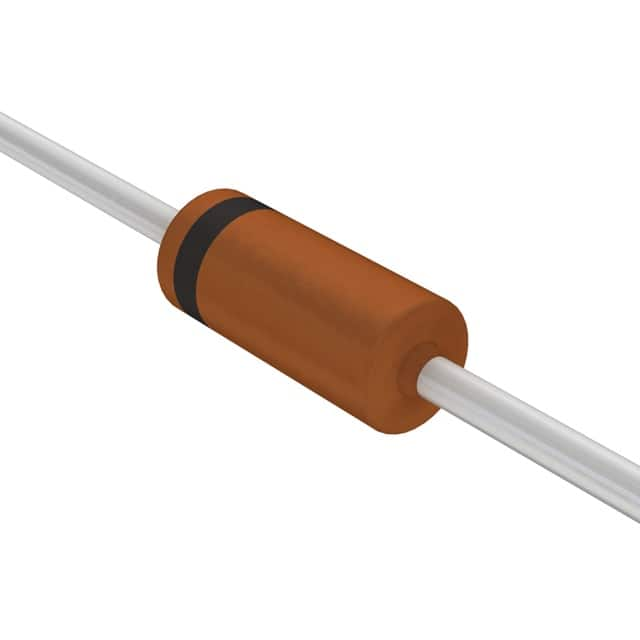BZX79-C3V9,113
Product Overview
Category
The BZX79-C3V9,113 belongs to the category of Zener diodes.
Use
It is commonly used for voltage regulation and protection in electronic circuits.
Characteristics
- Zener voltage: 3.9V
- Power dissipation: 500mW
- Package: DO-35
- Tolerance: ±5%
- Operating temperature range: -65°C to +200°C
Packaging/Quantity
The BZX79-C3V9,113 is typically available in reels or bulk packaging with quantities varying based on supplier and customer requirements.
Essence
The essence of the BZX79-C3V9,113 lies in its ability to maintain a constant voltage across its terminals when reverse biased.
Specifications
- Zener voltage: 3.9V
- Power dissipation: 500mW
- Maximum forward voltage: 1.2V
- Reverse current: 5μA
- Temperature coefficient: 5mV/°C
Detailed Pin Configuration
The BZX79-C3V9,113 has two pins and follows the standard pin configuration for DO-35 package diodes.
Functional Features
- Precise voltage regulation
- Overvoltage protection
- Stable operation over a wide temperature range
Advantages
- Small form factor
- High reliability
- Low cost
Disadvantages
- Limited power dissipation capability
- Sensitivity to temperature variations
Working Principles
The BZX79-C3V9,113 operates based on the principle of the Zener effect, where it maintains a nearly constant voltage drop across its terminals when reverse biased, providing stable voltage regulation and protection in electronic circuits.
Detailed Application Field Plans
The BZX79-C3V9,113 finds extensive use in various applications including: - Voltage regulation in power supplies - Overvoltage protection in electronic circuits - Signal clamping and limiting - Voltage reference in precision instruments
Detailed and Complete Alternative Models
Some alternative models to the BZX79-C3V9,113 include: - BZX79-C3V6,113 - BZX79-C4V3,113 - BZX79-C5V1,113 - BZX79-C6V2,113
In conclusion, the BZX79-C3V9,113 Zener diode offers precise voltage regulation and overvoltage protection, making it an essential component in various electronic circuits and systems.
Word count: 316
기술 솔루션에 BZX79-C3V9,113 적용과 관련된 10가지 일반적인 질문과 답변을 나열하세요.
What is the BZX79-C3V9,113 diode used for?
- The BZX79-C3V9,113 diode is commonly used for voltage regulation and transient voltage suppression in various technical solutions.
What is the maximum forward voltage of the BZX79-C3V9,113 diode?
- The maximum forward voltage of the BZX79-C3V9,113 diode is typically around 1.1V at a forward current of 5mA.
What is the breakdown voltage of the BZX79-C3V9,113 diode?
- The breakdown voltage of the BZX79-C3V9,113 diode is 3.9V, which makes it suitable for voltage clamping applications.
Can the BZX79-C3V9,113 diode be used for overvoltage protection?
- Yes, the BZX79-C3V9,113 diode can be used for overvoltage protection due to its ability to clamp voltages above its breakdown voltage.
What are the typical applications of the BZX79-C3V9,113 diode?
- Typical applications of the BZX79-C3V9,113 diode include voltage regulation in power supplies, overvoltage protection in electronic circuits, and transient voltage suppression in communication systems.
What is the power dissipation of the BZX79-C3V9,113 diode?
- The power dissipation of the BZX79-C3V9,113 diode is typically around 500mW, making it suitable for handling moderate power levels.
Is the BZX79-C3V9,113 diode suitable for high-frequency applications?
- Yes, the BZX79-C3V9,113 diode can be used in high-frequency applications due to its fast response time and low capacitance.
What is the temperature range for the BZX79-C3V9,113 diode?
- The BZX79-C3V9,113 diode is typically rated for a temperature range of -65°C to 175°C, allowing for operation in a wide range of environments.
Can the BZX79-C3V9,113 diode be used in automotive electronics?
- Yes, the BZX79-C3V9,113 diode is often used in automotive electronics for voltage regulation and transient suppression due to its robustness and reliability.
Are there any alternative diodes with similar characteristics to the BZX79-C3V9,113?
- Yes, other diodes with similar characteristics to the BZX79-C3V9,113 include the BZX79-C3V3,113 and BZX79-C4V3,113, which have slightly different breakdown voltages but share many common features.


